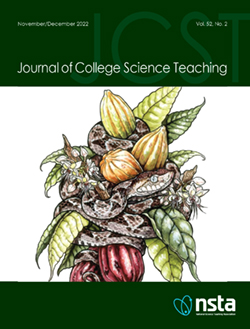Journal of College Science Teaching—November/December 2022

November/December 2022
Volume 52, Number 2
This issue’s Research and Teaching column includes the following: a qualitative assessment of BSN student responses to an online lab exercise; STEM graduate students’ development as leaders, researchers and innovators; how Interactive physical course materials provide unique formative assessment opportunities, an eye-opening study on Inclusive practices in major and non-major courses in biology and geology; student perspectives on anticipatory activities using innovative apps; instructor perspectives on pedagogical change. In the Features column you will find: a thoughtful description how to successfully implement a truly flipped classroom; strategies to facilitate student acceptance of evolution; teaching homeostasis using short predict-observe-explain activities. Our Case Study this month investigates the use of video documentary storytelling in science education where students are science content creators and evaluators. In our special Remote Learning – Strategies in Response to the COVID-19 Pandemic column we give you an example of a service learning through citizen science strategy used during the pandemic when most university F2F courses were temporarily using online instruction.
Journal Article
Students as Science Content Creators and Evaluators
Within the context of higher education, the disciplines of science and filmmaking appear disparate, but the importance of storytelling as an integral part of science and research deserves closer examination. Humans have always used stories to share i...
By Erica B. Walker and Kelly B. Lazar
Journal Article
Service-Learning Through Citizen Science in a COVID-Adapted Classroom
Classrooms were turned upside down amid the global COVID-19 pandemic, which began approximately halfway through the spring 2020 semester. A service-learning project was implemented in my section of a general biology course for majors. With the shutdo...
By Joanna J. Cielocha
Journal Article
The Constructivist Flipped Classroom
In science education, the value of the constructivist methodology has long been integrated with experiential and hands-on learning while offering a framework for teaching and learning. In recent pre- and future postpandemic times, as various online m...
By William H. Robertson
Journal Article
Student Acceptance of Evolution
Acceptance of human evolution seems to be the majority position for the U.S. population; however, acceptance of evolution among conservative Christian groups is low, sometimes below 50%. There are many different reasons for this low acceptance, leadi...
By Daniel G. Ferguson, Jamie L. Jensen, Adhieu Arok, Seth M. Bybee, and T. Heath Ogden
Journal Article
Historically, undergraduate anatomy and physiology (A&P) has been a challenging course for incorporating conceptual learning techniques due to large class sizes and an emphasis on content and terminology. The project utilized the Predict-Observe-...
By Sammi Moore, Ron Gray, and Jeff Meilander
Journal Article
Connecting pH and Molarity to Health Care
Given the recent state of social distancing, the online lab experience discussed in this article offers an economical and versatile approach to online undergraduate chemistry lab instruction. With videoconferencing software, this experience is easily...
By Angela L. Mahaffey
Journal Article
STEM Graduate Students’ Development at the Intersection of Research, Leadership, and Innovation
Researcher innovation and leadership skills are fundamental for creating implementable solutions to pressing societal and market-based global problems. The Research to Innovation to Society (R2I2S) program is a transformative approach to graduate edu...
By Cindy Lenhart, Jana Bouwma-Gearhart, Douglas A. Keszler, Judith Giordan, Rich Carter, and Michelle Dolgos
Journal Article
Physical and life science disciplines emphasize how basic structural units influence function, yet it is challenging for students to understand structure-function relationships, particularly at molecular scales. Undergraduates in our biology capstone...
By Robin Forbes-Lorman, Michele Korb, Amy Moser, Margaret A. Franzen, and Michelle A. Harris
Journal Article
Intentionally Addressing Equity in the Classroom
Equity, as we define it, means striving to serve the needs of others and enhancing belonging by focusing on “whole humans” in emotional, sociocultural, and personal contexts. Integrating equitable practices in STEM classrooms has advantages rangi...
By Jessica Kansman*, Makenzie E. Mabry*, Aaron Morrison*, Stephanie Rosbach*, and Marcelle A. Siegel
Journal Article
Computing in Bioinformatics and Engaged Student Learning
The field of biology education—and other science, technology, engineering, and mathematics (STEM) disciplines more broadly—has witnessed two major shifts in the past decade: (i) the increased awareness of research-based instructional strategies (...
By Tina A. Marcroft, Chris Rasmussen, and Scott T. Kelley
Journal Article
A Process of Pedagogical Change in College Science Education
This article aims to explore the experiences of science instructors who are active participants in the design and enactment of an interdisciplinary science course with student-centered pedagogy in a large-enrollment class. The data were collected thr...
By Ozden Sengul


